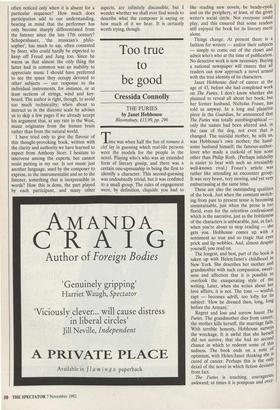Too true to be good
Cressida Connolly
THE FURIES by Janet Hobhouse Bloomsbury, £15.99, pp. 296 Time was when half the fun of romans ii clef lay in guessing which real-life persons were the models for the people in the novel. Playing who's who was an extended form of literary gossip, and there was a certain one-upmanship in being the first to identify a character. This second-guessing was undoubtedly trivial, but it was confined to a small group. The rules of engagement were, by definition, cliquish: you had to
like reading new novels, be beady-eyed, and on the periphery, at least, of the given writer's social circle. Not everyone could play, and this ensured that some readers still enjoyed the book for its literary merit alone.
Things change. At present there is a fashion for writers — and/or their subjects — simply to come out of the closet and admit who's who at the time of publication. No detective work is now necessary. Buying a national newspaper will ensure that all readers can now approach a novel armed with the true identity of its characters.
Janet Hobhouse died of cancer at the age of 43, before she had completed work on The Furies. I don't know whether she planned to reveal all about her book; but her former husband, Nicholas Fraser, has told us anyway. In a long and plaintive piece in the Guardian, he announced that The Furies was totally autobiographical — only the names had been altered and, in the case of the dog, not even that is changed. The suicidal mother, he tells us, was Hobhouse's own mother; the hand- some husband himself; the famous-author- lover who made a cuckold of him none other than Philip Roth. (Perhaps infidelity is easier to bear with such an irresistibly well-known rival.) Fraser's article was rather like attending an encounter group. It was very brave, very moving, and yet very embarrassing at the same time. These are also the outstanding qualities of the book. Just when the constant switch- ing from past to present tense is becoming unsustainable, just when the prose is too florid, even for the relentless confessional which is the narrative, just as the brittleness of the characters is unbearable, just, in fact, when you're about to stop reading — she gets you. Hobhouse comes up with a sentiment so true and so tragic that eyes prick and lip wobbles. And, almost despite yourself, you read on.
The longest, and best, part of the book Is taken up with Helen/Janet's childhood in New York. She describes her mother and grandmother with such compassion, sweet- ness and affection that it is possible tu overlook the exasperating style of the writing. Later, when she writes about her love affairs, it is not. The tone — wistful, rapt — becomes adrift, too lofty for its subject: 'How he dressed then, long, long before the Armani.'
Regret and loss and sorrow haunt The Furies. The grandmother dies from cancer, the mother kills herself, the marriage fails. With terrible honesty, Hobhouse surYeYs the wreckage. It is awful that she herself did not survive, that she had no second chance in which to redeem some of this sadness. The book ends on a note u.f optimism, with Helen/Janet thinking she is cured of cancer. Perhaps this is the onlY detail of the novel in which fiction deviates from fact.
The Furies is touching, courageous, awkward; at times it is pompous and over
flowery. But it is a remarkable account of familial love, and the love of mothers and daughters in particular. Facing the possibil- ity of her own death, Hobhouse writes:
I'd loved a lot and I'd been loved, and in the end, which this seemed to be, that was all that mattered.











































































 Previous page
Previous page